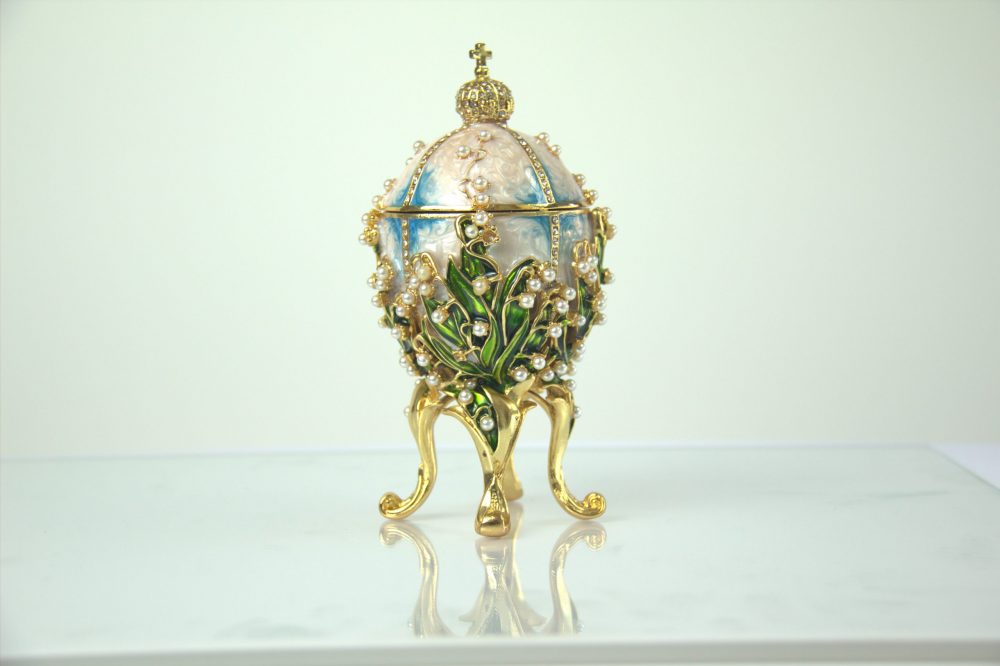The story of the Lilies of the Valley Faberge egg
Faberge eggs are beautiful pieces of art that many people still look for today. These eggs have left a profound mark on many different cultures around the world. That is why so many people wish to own one or have a replica.
This post is going to tell you everything you need to know about the Lilies of the Valley Faberge Egg.
Origins of the Lilies of the Valley Faberge Egg
This Art Nouveau-style egg is one of two that follow this design. The other egg in this style is the Pansy egg. On April 5th, it was given to Tsar Nicholas II. It was a gift for his wife, Alexandra Feodorovna, the Tsarina Empress. The reason eggs are made and given is because it was a tradition made by the Russian Orthodox Church.
Every Easter, the tsar needs to present a Faberge egg to a member of their family. In 1898, Tsar Nicholas II decided that the egg would go to his wife.
The Empress was impressed with the design of the egg. The egg itself is surrounded by pearls, and on the top of the guilloche field, it has rose-pink enamel. In order for the egg to be supported appropriately, it rests on cabriole legs of gold-green leaves and diamonds that are rose-cut into dewdrops. The lilies have enameled leaves that are green and gold flowers that have been set with rubies, diamonds, and pearls. This is an egg that is breathtaking to many.
Lilies of the Valley Faberge Egg Details and Dimensions
It is 151 millimeters in height when closed and 199 millimeters when opened. As for the surprise inside, it is elevated when the single gold-mounted pearl is twisted. Three portraits appear when it is fully raised and are visible under the imperial crown. There was a portrait of Tsar Nicholas II, Grand Duchess Olga, and Grand Duchess Tatiana – his two daughters. The portraits retreat into the egg if you twist the pearl the other way.
All three portraits are found in frames made of rose-gold diamonds and have engraved gold panel backings. The date, July 31st, 1898, is engraved because that was the date that the egg was presented to Alexandra Feodorovna.
This egg was made with so many flowers because Empress Alexandra Feodorovna was a lover of flowers. She typically had trains arrive with flowers to St. Petersburg from the Crimea to sit at Alexander Palace. Some say that she would fill rooms up with flowers.
Her favorite flower was lilies of the valley, and pearls were one of her favorite jewels. Moreover, the lilies of the valley represent conjugal bliss and domestic happiness. Tsar Nicholas II made sure to tell Michael Perchin this information because he wanted the egg to represent his wife perfectly. That is why her favorite flower and jewel were incorporated into the egg.
Additionally, this egg was a companion to the Coronation Egg when sold in 1979 by Wartski of London. The eggs sold for $2,160,000 to Forbes Magazine Collection. However, in 2004, the two eggs were sold to Viktor Vekselberg, so they could return to Russia and be displayed in the Faberge Museum.
Who Created the Lilies of the Valley Faberge egg?
Made under the supervision of the Russian jeweler Peter Carl Faberge, the Lilies of the Valley was made in 1898. The goldsmith that was supervising was Michael Perchin. All three portraits were painted by Johannes Zehngraf.
Impact on the Faberge Field
The Lilies of the Valley egg did not have an impact on the Faberge field, but it was different compared to the other eggs. In order for the three portraits to come out of the egg, a single pearl needs to be twisted at the top. This is significant because, usually, the eggs need to be turned themselves or opened.
That is why the Lilies of the Valley Faberge egg was such a unique egg because the mechanism that the artisans needed to make and use was very complex.
Additionally, word spread that Alexandra Feodorovna loved the lilies of the valley and that she adored her Faberge egg. That is why workmaster August Wilhelm Holmstrom made the Lilies of the Valley Basket. It is made up of nineteen individual stems that are decorated with diamonds and pearls.
This creation was presented to Alexandra Feodorovna when she visited the Pan-Russian Exhibition in 1896. In fact, she treasured this basket so much that it was kept in her room on her bedside table.
However, the basket was sold. It was purchased by The Metropolitan Museum of Art on November 22nd, 2011, and is displayed in the Faberge from The Matilda Geddings Grey Foundation Collection. It is now considered to be the most important Faberge piece in the United States.
Where Can You Find the Lilies of the Valley egg Today?
The collection that the egg is part of is the Victor Vekselberg Collection. This collection is owned by The Link of Times Foundation. You would need to go to the Faberge Museum in Saint Petersburg, Russia, to see this egg. This egg is worth $13 million, but it is not on sale.
There are sites that allow you to buy replicas of this real Faberge egg if you want. However, it is essential to buy one from a reputable source. With so many sellers online, there are many souvenirs that look similar to the real Faberge egg.
Except, there are some replicas that look nothing similar to the authentic Faberge egg. That is why it is essential to do your research before purchasing one because you could end up disappointed with the replica.
Make sure to check out our website to see our replica Faberge eggs.
Conclusion
Faberge eggs are beautiful pieces of art that stand the test of time. Many people from all over the world travel to see the ones on display in Russia. Also, the meaning behind each egg is so important because they all encapsulate history.
It is no surprise that many people want their version of the beautiful eggs. If you want a replica of the Lilies of the Valley Egg, then make sure to check out our website for the Lilies of the Valley Faberge egg replica and other replicas as well.
My name is Sasha, I’m a father of two. Work in the tech industry. For fun I am running a small business in addition to that, sometimes I write and edit content regarding topics that interest me like: entertainment, tech, finance and art.


Leave a Reply
You must be logged in to post a comment.